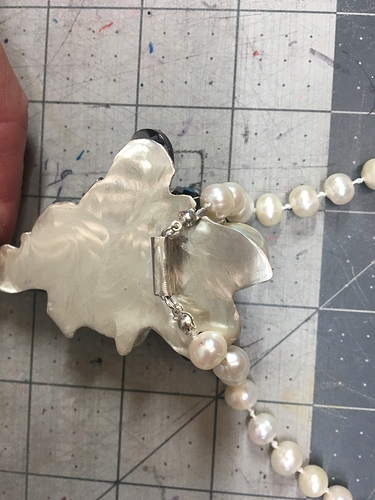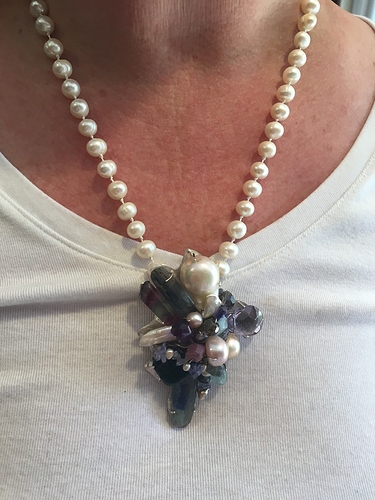Necklace - cbutchko11@gmail.com - Gmail.pdf (896 Bytes)
I am having trouble setting bails on the back of my pieces, so that the piece hangs straight. I prefer that that the necklace comes out of the side of the piece, rather than hanging down straight from the top. Also should I solder the bails on first, before adding the prongs?Bails - cbutchko11@gmail.com - Gmail.pdf (896 Bytes)
bails#3.pdf (896 Bytes)
bails#2.pdf (896 Bytes)
Well CBbutchko 11 ,
If you attached photo I couldn’t get them to open. I will offer this thought: Often we are fighting what we would prefer with what the jewelry will do. Gravity has its way with pendants and the moment you add a chain they want to self balance and hang what ever way the pendant chooses. This will become an exercise in how you balance weight and material. Look at Alexander Calder’s mobiles and you’ll see what I mean.
Don Meixner
try saving your images as a jpg, gif, png, etc … and NOT as a pdf because its not saving the image correctly as a pdf so no one can open them to see what the images are.
That is a good idea, thank you AlyssaKay
Thank you Don, I know now that the pictures did not download. But what I did is rubber cement a thick string to the back and tape over it with painter’s tape at different spots. Then I loosely set my piece in and tested the balance. I then soldered a small tube to the back of my piece and ran a small chain through it and attached my knotted pearls to the chainIMG_2300|375x500
I value your input as in life I always try to run before I can walk!
Ah, all is clear now. A good solution on your part. Using a tube forces a balance that you wouldn’t get otherwise on a piece like you show. I have several irregular pendants that I have two bails on. This allows me to show hanging from three different aspects in a show display which is kind of fun.
I have the habit of getting tied up in the visual of the piece that I completely forget about the bail until the very last when commonsense should have me adding it in sometime sooner. I like a fairly stout bail, 16-18 ga. round wire because my pendants are largish. So I should plan better than I do. Also I rarely work with stones or prong settings. That’s Brother Rob’s wheel house and he is very good at it. His advice there would be be more complete that mine.
Don Meixner
Thanks again Don, I was trying the two bail idea but I was using 22ga.
Probably much too small. I think I was also trying to be much two fancy with the bails. Perhaps you could post a picture of the bails you used on the pendant that you mention? I would like to see what they looked like. I also wait too long to figure out my bails, but in multi stone pieces like the one pictured I can’t account for the weight and balance until I semi set the piece. ![IMG_2295|375x500]
I aappreciate your help. Christina(upload://ywCbPfRoTrr884GggL5g9UcORcX.jpeg)
A pendant or anything else suspended from a single point will always hang with the center of gravity directly below the point of suspension. The only true solution is to design pieces that have the center of gravity directly below where you want the bail, which means designing around the bail position. As Don suggested, using two bails or a tube that allows the suspension to become a range of suspension rather than a single point, can work to a degree, but it won’t really solve the problem, especially if the piece is heavily asymmetrical…
If you want an asymmetrical look the best way to achieve that is to make the thinner side heavier. If it makes it any easier to swallow, even Sir Isaac Newton and Albert Einstein were occasionally stymied by how physics interfered with their concepts and designs too .
I sometimes use a pair of tweezers with the ends bent inwards.
You can the try grabbing the two sides of the pendant and repositioning to find the position of the bail which would best suit the way you want it to hang. Using fingers with a light touch will also give you a fair idea.
Thank you Dave, that is a good idea
You will find your pearls are going to go vertical from the end of the tubing or any bail since they are on a limp fiber. You could add wire into your stringing material to make it more rigid.
You could omit the fiber and knots and instead use a more rigid coated metal cable like a Beadalon. The wires are available in multiple strands, thicknesses and rigidity It can create more of an Oval or Collar look to your pearls.
I have used small mm stones between my pearls to create a knot-like appearance.
If you want the pearls to come out at a more horizontal position extend the tubing to the edges of the back of the pendant. In other words use a longer piece.
This may cause a problem with your bead ends showing. So… I like the idea above that calls for two bail tubes. Maybe try one at both ends and your pearl connection can be made at the open center of those tubes.
Simplified = * =
I like your idea of taping on the bail. I have always dangled a pendant from my tweezers to get a feel of the balance if in doubt. I test my bail placement by hanging it from a scrap wire or chain after the fact.
I would say yes on your soldering your bails before prongs. I say that because prongs are typically thinner and smaller than bails. Thinner and smaller has the potential to melt in a puddle.
Lovely Work!
dll
Thank you Debra!

